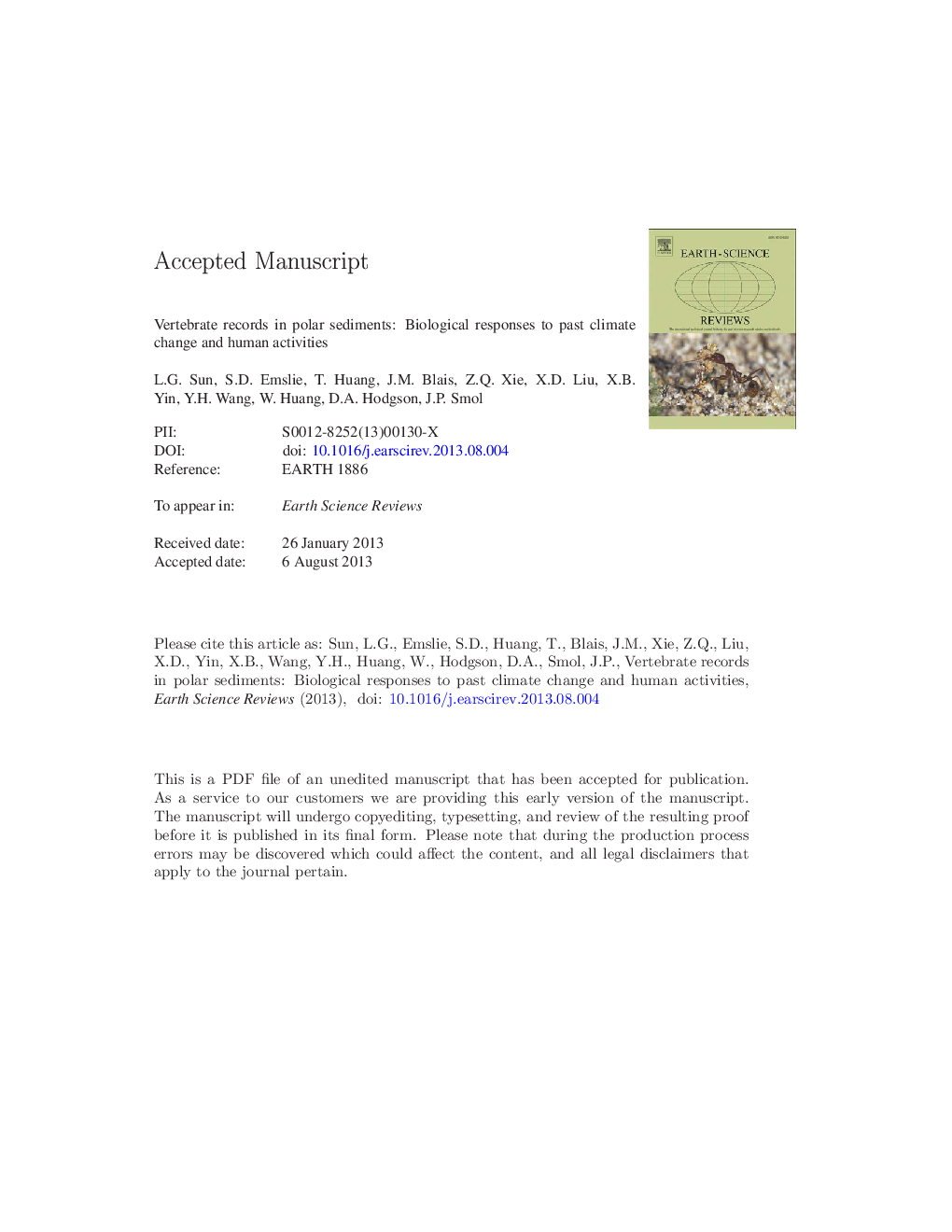| کد مقاله | کد نشریه | سال انتشار | مقاله انگلیسی | نسخه تمام متن |
|---|---|---|---|---|
| 6443086 | 1639976 | 2013 | 29 صفحه PDF | دانلود رایگان |
عنوان انگلیسی مقاله ISI
Vertebrate records in polar sediments: Biological responses to past climate change and human activities
ترجمه فارسی عنوان
پرونده های مهره دار در رسوبات قطبی: پاسخ های بیولوژیکی به تغییرات اقلیمی گذشته و فعالیت های انسانی
دانلود مقاله + سفارش ترجمه
دانلود مقاله ISI انگلیسی
رایگان برای ایرانیان
کلمات کلیدی
ترجمه چکیده
پاسخ های بیولوژیکی به تغییرات آب و هوایی و تغییرات محیط زیست در قطب های دوردست در حال افزایش علاقه به تحقیقات جهانی تغییر است. اکوسیستم های قطبی زمین و دریا از تاثیرات هر دو تغییرات جوی و تغییرات شدید انسانی رنج می برند و در دهه های گذشته تغییرات بزرگی در تعداد گونه های دریایی، دریاها و کریستال های قطب جنوب دیده شده است. برای درک مکانیسم های رانندگی این رژیم در اکوسیستم های قطبی، مهم است که ابتدا تأثیرات اعمال طبیعی از فعالیت های انسان شناسی را تشخیص دهیم. بنابراین، بررسی تغییرات گذشته در اکوسیستم های قطبی قبل از تماس با انسان برای قرار دادن تغییرات ناشی از تغییرات اخیر انسان در یک زمینه تاریخی طولانی مدت مرتبط است. در اینجا ما بررسی خود را در بقایای فسیلی، زیر فسیلی، باستان شناسی و بیوگرافی شیمیایی دریاهای مهره دار در رسوبات قطبی تمرکز می کنیم. این باقی مانده ها شامل بافت هایی نظیر استخوان ها، موها و پرها و نشانگرهای بیوگرافی و شیمیایی و دیگر شاخص های پروکسی، از جمله ذخایر گوانو و اکستنشن است که می تواند در هزاران سال در رسوبات دریاچه و زمین انباشته شود. تجزیه و تحلیل این باقی مانده ها در طول هزاران سال به بینش هر دو اثر طبیعی و انسان شناسی بر مهره های دریایی کمک کرده است و به عوامل شناسایی عوامل این اثرات کمک کرده است. علاوه بر این، دریایی های سرزمینی و پستانداران دریایی به عنوان بردارهای زیست محیطی در محیط های قطبی نقش مهمی ایفا می کنند زیرا میزان قابل توجهی از مواد مغذی و آلودگی های آلودگی بین اقیانوس ها و اکوسیستم های زمینی را حمل می کنند.
موضوعات مرتبط
مهندسی و علوم پایه
علوم زمین و سیارات
زمین شناسی
چکیده انگلیسی
Biological responses to climate and environmental changes in remote polar regions are of increasing interest in global change research. Terrestrial and marine polar ecosystems have suffered from impacts of both rapid climate change and intense human activities, and large fluctuations in the population sizes of seabirds, seals, and Antarctic krill have been observed in the past decades. To understand the mechanisms driving these regime shifts in polar ecosystems, it is important to first distinguish the influences of natural forcing from anthropogenic activities. Therefore, investigations of past changes of polar ecosystems prior to human contact are relevant for placing recent human-induced changes within a long-term historical context. Here we focus our review on the fossil, sub-fossil, archaeological, and biogeochemical remains of marine vertebrates in polar sediments. These remains include well-preserved tissues such as bones, hairs and feathers, and biogeochemical markers and other proxy indicators, including deposits of guano and excrement, which can accumulate in lake and terrestrial sediments over thousands of years. Analyses of these remains have provided insight into both natural and anthropogenic impacts on marine vertebrates over millennia and have helped identify the causal agents for these impacts. Furthermore, land-based seabirds and marine mammals have been shown to play an important role as bio-vectors in polar environments as they transport significant amounts of nutrients and anthropogenic contaminants between ocean and terrestrial ecosystems.
ناشر
Database: Elsevier - ScienceDirect (ساینس دایرکت)
Journal: Earth-Science Reviews - Volume 126, November 2013, Pages 147-155
Journal: Earth-Science Reviews - Volume 126, November 2013, Pages 147-155
نویسندگان
L.G. Sun, S.D. Emslie, T. Huang, J.M. Blais, Z.Q. Xie, X.D. Liu, X.B. Yin, Y.H. Wang, W. Huang, D.A. Hodgson, J.P. Smol,
